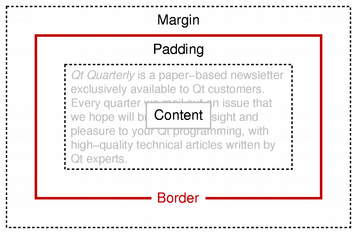PySide6.QtGui.QTextFrameFormat¶
- class QTextFrameFormat¶
The
QTextFrameFormatclass provides formatting information for frames in aQTextDocument.Details
A text frame groups together one or more blocks of text, providing a layer of structure larger than the paragraph. The format of a frame specifies how it is rendered and positioned on the screen. It does not directly specify the behavior of the text formatting within, but provides constraints on the layout of its children.
The frame format defines the
width()andheight()of the frame on the screen. Each frame can have aborder()that surrounds its contents with a rectangular box. The border is surrounded by amargin()around the frame, and the contents of the frame are kept separate from the border by the frame’spadding(). This scheme is similar to the box model used by Cascading Style Sheets for HTML pages.
The
position()of a frame is set usingsetPosition()and determines how it is located relative to the surrounding text.The validity of a
QTextFrameFormatobject can be determined with theisValid()function.See also
Inherited by:
QTextTableFormatSynopsis¶
Methods¶
def
__init__()def
border()def
borderBrush()def
borderStyle()def
bottomMargin()def
height()def
leftMargin()def
margin()def
padding()def
position()def
rightMargin()def
setBorder()def
setBorderBrush()def
setBorderStyle()def
setHeight()def
setLeftMargin()def
setMargin()def
setPadding()def
setPosition()def
setRightMargin()def
setTopMargin()def
setWidth()def
topMargin()def
width()
Note
This documentation may contain snippets that were automatically translated from C++ to Python. We always welcome contributions to the snippet translation. If you see an issue with the translation, you can also let us know by creating a ticket on https:/bugreports.qt.io/projects/PYSIDE
- class Position¶
This enum describes how a frame is located relative to the surrounding text.
Constant
Description
QTextFrameFormat.Position.InFlow
QTextFrameFormat.Position.FloatLeft
QTextFrameFormat.Position.FloatRight
See also
- class BorderStyle¶
This enum describes different border styles for the text frame.
Constant
Description
QTextFrameFormat.BorderStyle.BorderStyle_None
QTextFrameFormat.BorderStyle.BorderStyle_Dotted
QTextFrameFormat.BorderStyle.BorderStyle_Dashed
QTextFrameFormat.BorderStyle.BorderStyle_Solid
QTextFrameFormat.BorderStyle.BorderStyle_Double
QTextFrameFormat.BorderStyle.BorderStyle_DotDash
QTextFrameFormat.BorderStyle.BorderStyle_DotDotDash
QTextFrameFormat.BorderStyle.BorderStyle_Groove
QTextFrameFormat.BorderStyle.BorderStyle_Ridge
QTextFrameFormat.BorderStyle.BorderStyle_Inset
QTextFrameFormat.BorderStyle.BorderStyle_Outset
See also
- __init__()¶
Constructs a text frame format object with the default properties.
- __init__(fmt)
- Parameters:
fmt –
QTextFormat
- border()¶
- Return type:
float
Returns the width of the border in pixels.
See also
Returns the brush used for the frame’s border.
See also
- borderStyle()¶
- Return type:
Returns the style of the frame’s border.
See also
- bottomMargin()¶
- Return type:
float
Returns the width of the frame’s bottom margin in pixels.
See also
- height()¶
- Return type:
Returns the height of the frame’s border rectangle.
See also
- leftMargin()¶
- Return type:
float
Returns the width of the frame’s left margin in pixels.
See also
- margin()¶
- Return type:
float
Returns the width of the frame’s external margin in pixels.
See also
- padding()¶
- Return type:
float
Returns the width of the frame’s internal padding in pixels.
See also
- pageBreakPolicy()¶
- Return type:
Combination of
PageBreakFlag
Returns the currently set page break policy for the frame/table. The default is
PageBreak_Auto.See also
Returns the positioning policy for frames with this frame format.
See also
- rightMargin()¶
- Return type:
float
Returns the width of the frame’s right margin in pixels.
See also
- setBorder(border)¶
- Parameters:
border – float
Sets the
width(in pixels) of the frame’s border.See also
Sets the
brushused for the frame’s border.See also
- setBorderStyle(style)¶
- Parameters:
style –
BorderStyle
Sets the
styleof the frame’s border.See also
- setBottomMargin(margin)¶
- Parameters:
margin – float
Sets the frame’s bottom
marginin pixels.See also
- setHeight(height)¶
- Parameters:
height –
QTextLength
Sets the frame’s
height.See also
- setHeight(height)
- Parameters:
height – float
Sets the frame’s
height.- setLeftMargin(margin)¶
- Parameters:
margin – float
Sets the frame’s left
marginin pixels.See also
- setMargin(margin)¶
- Parameters:
margin – float
Sets the frame’s
marginin pixels. This method also sets the left, right, top and bottom margins of the frame to the same value. The individual margins override the general margin.See also
- setPadding(padding)¶
- Parameters:
padding – float
Sets the
widthof the frame’s internal padding in pixels.See also
- setPageBreakPolicy(flags)¶
- Parameters:
flags – Combination of
PageBreakFlag
Sets the page break policy for the frame/table to
policy.See also
Sets the
policyfor positioning frames with this frame format.See also
- setRightMargin(margin)¶
- Parameters:
margin – float
Sets the frame’s right
marginin pixels.See also
- setTopMargin(margin)¶
- Parameters:
margin – float
Sets the frame’s top
marginin pixels.See also
- setWidth(length)¶
- Parameters:
length –
QTextLength
Sets the frame’s border rectangle’s
width.See also
- setWidth(width)
- Parameters:
width – float
Convenience method that sets the width of the frame’s border rectangle’s width to the specified fixed
width.- topMargin()¶
- Return type:
float
Returns the width of the frame’s top margin in pixels.
See also
- width()¶
- Return type:
Returns the width of the frame’s border rectangle.
See also